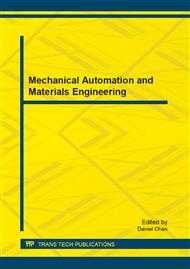[1]
A.H. Nayfeh and D.T. Mook. Nonlinear Oscillations. Wiley, New York, (1997).
Google Scholar
[2]
S. Smith and J. Tlusty. Efficient simulation programs for chatter in milling. CIRP Annals, 42: 463–466, (1993).
DOI: 10.1016/s0007-8506(07)62486-x
Google Scholar
[3]
Y. Altintas and E. Budak. Analytical prediction of stability lobes in milling. CIRP Annals-Manufacturing Technology, 44: 357–362, (1995).
DOI: 10.1016/s0007-8506(07)62342-7
Google Scholar
[4]
E. Budak and Y. Altintas. Analytical prediction of chatter stability in milling-part i: general formulation, journal of dynamic systems. Measurement and Control, Transactions of the ASME, 120: 22–30, (1998).
DOI: 10.1115/1.2801317
Google Scholar
[5]
P.V. Bayly, T.L. Schmitz B.P. Mann, D.A. Peters, G. Stepan, and T. Insperger. Effects of radial immersion and cutting direction on chatter instability in end-milling. In Proceedings of IMECE2002, volume 13, pages 351–363, (2002).
DOI: 10.1115/imece2002-39116
Google Scholar
[6]
P.V. Bayly, J.E. Halley, B.P. Mann, and M.A. Davies. Stability of interrupted cutting by temporal finite element analysis. In Proceedings of the ASME Design Engineering Technical Conference, volume 6C, pages 2361–2370, (2001).
DOI: 10.1115/detc2001/vib-21581
Google Scholar
[7]
T. Insperger and G. Stepan. Semi-discretization method for delayed systems. International Journal for Numerical Methods in Engineering, 55: 503–518, (2002).
DOI: 10.1002/nme.505
Google Scholar
[8]
T. Insperger and G. Stepan. Updated semi-discretization method for periodic delay-differential equations with discrete delay. International Journal for Numerical Methods in Engineering, 61: 117–141, (2004).
DOI: 10.1002/nme.1061
Google Scholar
[9]
Ye Ding, LiMin Zhu, XiaoJian Zhang, and Han Ding. A full-discretization method for prediction of milling stability. International Journal of Machine Tools and Manufacture, 50: 502–209, (2010).
DOI: 10.1016/j.ijmachtools.2010.01.003
Google Scholar
[10]
Ye Ding, LiMin Zhu, XiaoJian Zhang, and Han Ding. Second-order full-discretization method for milling stability prediction. International Journal of Machine Tools and Manufacture, 50: 926–932, (2010).
DOI: 10.1016/j.ijmachtools.2010.05.005
Google Scholar
[11]
T. Insperger. Full-discretization and semi-discretization for milling stability prediction: some comments. International Journal of Machine Tools and Manufacture, 50: 658–662, (2010).
DOI: 10.1016/j.ijmachtools.2010.03.010
Google Scholar


